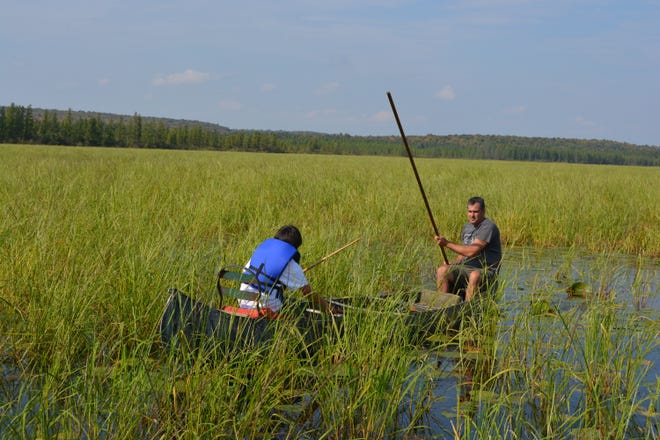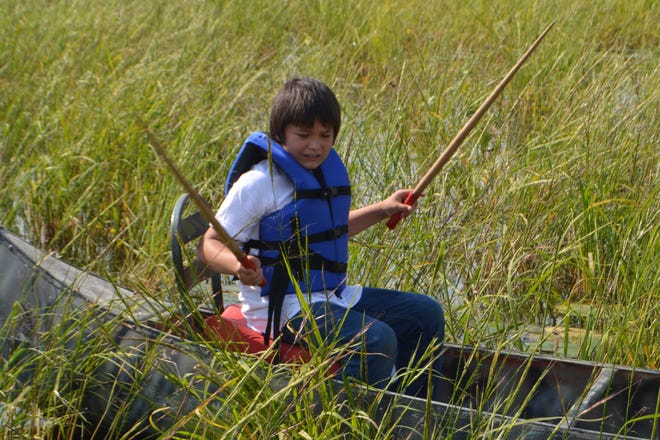Sokaogon Chippewa Community Continues to Harvest Wild Rice

MOLE LAKE - When the government forced the original inhabitants of northern Wisconsin, the Ojibwe, onto reservations a fraction of the size of their territory almost 200 years ago, tribal leaders knew exactly which tracts of land would be best for their people.
They chose areas that had the best lakes and wetlands that produced wild rice unique to this part of the world.
"When the BIA (Bureau of Indian Affairs) agent came to ask why we chose this place for our reservation, our chief showed him a handful of wild rice," said Peter McGeshick III, a rice chief with the Sokaogon Community of Mole Lake Band of Lake Superior Chippewa, who has been harvesting rice for more than 50 years on the reservation in Forest County in northeast Wisconsin.
When harvested in the late summer to early fall, the rice could be enough to sustain them through the harsh winter months.
Wild rice today remains such an integral part of the culture of the Ojibwe, as well as other Indigenous nations in Wisconsin, such as the Potawatomi and Menominee.
Also known as manoomin in Ojibwe, wild rice that grows in Wisconsin and Minnesota has a rich and nutty flavor and isn't found anywhere else in the world.
RELATED: Wisconsin wild rice is unique in the world, but some worry about effects of climate change
RELATED:Here's how Indigenous wild rice is helping restore wetlands in the Green Bay area

The Ojibwe had once lived on the eastern seaboard, according to the tribal migration story, and there was a prophecy that stated if they wanted to survive as a people they would have to move west.
They kept moving westward for several generations as the prophecy commanded until they found "a place where the food grows on water" and they finally found their home in northern Wisconsin and Minnesota.
Wild rice beds were once abundant in Wisconsin, but today rice chiefs and scientists with the tribes are working with the Department of Natural Resources and the Great Lakes Indian Fish & Wildlife Commission to protect the remaining rice lakes from further damage.
McGeshick said seven bodies of water had once grown wild rice on the reservation, but increasing water levels, such as from run-off water, have decreased that to only one body of water they call Rice Lake.
This year, Nathan Podany, hydrogeologist for Sokaogon, became concerned when he noticed a bright, blue-green algae floating on Mole Lake.
"My first thought was that we needed to document the algae through photos so our environmental department could verify that it was blue-green algae," he said.
Podany then contacted the DNR and was put in touch with Gina LaLiberte, the state's harmful algal bloom coordinator.
She said the algae is a native bottom-dwelling organism that somehow broke off the bottom this year and floated to the top.
"This has probably always been in the lake, but it doesn't get noticed until it floats from the bottom," LaLiberte said.
She said the algae can make people and pets sick if ingested and tribal officials are warning their citizens to steer clear of high concentrations in the water.
"We know that blue green algae can be found in almost any lake, but are exacerbated when specific conditions arise," Podany said. "Our goal is to continue to monitor the lake to better understand water quality now and in the future."
While lakes on reservations are only open to tribal citizens, there are still nearly 100 lakes in Wisconsin that have wild rice beds available for harvest by the general public.
Officials with the DNR and GLIFWC said harvesters should not used motorized propellers through the rice beds, which can damage them, but should instead use push poles for navigation, a technique developed by Indigenous people that is minimally invasive.

Some lakes can only be harvested during specified dates as determined by GLIFWC and DNR.
Harvesters also are advised to wear bright clothes and display a red flag from their boats because the season coincides with waterfowl hunting season.
A full list of harvestable wild rice beds can be found online at https://data.glifwc.org/manoomin.harvest.info/.
Frank Vaisvilas is aReport For America corps member based at the Green Bay Press-Gazette covering Native American issues in Wisconsin. He can be reached at 815-260-2262 or fvaisvilas@gannett.com, or on Twitter at @vaisvilas_frank. Please consider supporting journalism that informs our democracy with a tax-deductible gift to this reporting effort at GreenBayPressGazette.com/RFA.
Source: https://www.greenbaypressgazette.com/story/news/native-american-issues/2022/08/24/wisconsin-wild-rice-season-nears-lakes-for-tribal-public-harvesting/7843720001/
0 Response to "Sokaogon Chippewa Community Continues to Harvest Wild Rice"
Post a Comment